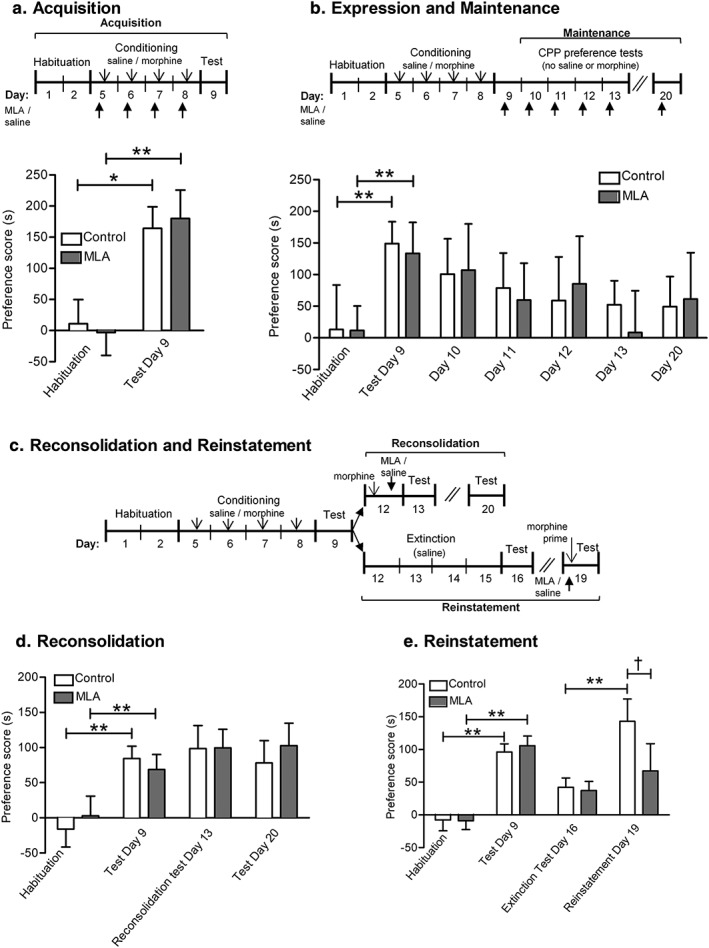Figure 1.

Effect of MLA on stages of morphine‐CPP in C57BL/6 mice. (a) Acquisition. Mice were tested for any innate preference for a particular chamber (Habituation) and then pseudo‐randomly allocated to two groups with comparable mean preference scores. The MLA group received MLA (4 mg/kg) 20 minutes prior to a conditioning dose of morphine (10 mg/kg) or saline, paired with alternative compartments, on 4 consecutive days. The control group received saline instead of MLA. A preference test was conducted on the next day, giving the animals free access to both compartments of the CPP apparatus for 15 minutes. Preference scores indicate the time spent in the morphine‐paired compartment in seconds minus 450 (half of the total time). Data are expressed as the mean ± S.E.M. Both groups showed significant acquisition of morphine‐CPP (*saline: P < 0.05, **MLA: P < 0.005, n = 16 per group) indicating that MLA treatment had no effect on the acquisition of morphine‐CPP. (b) Maintenance. Mice were allocated to two groups and both groups were treated identically, to acquire morphine‐CPP as in (a). They were tested for expression of morphine‐CPP on 5 consecutive days and 1 week later. One group received MLA (4 mg/kg) 20 minutes prior to each preference test, the control group received saline instead of MLA. Both groups acquired morphine‐CPP (**P < 0.005, n = 12 per group). MLA treatment had no effect on the expression of morphine‐CPP during the maintenance phase. (c) Schematic for reconsolidation and reinstatement experiments. (d) Reconsolidation. Two groups of mice were treated identically, to acquire morphine‐CPP as in (a). Three days later mice received a further dose of morphine (10 mg/kg) in the drug‐paired compartment. Immediately afterwards, one group received MLA (4 mg/kg) while the control group received saline. The mice underwent a preference test the next day and one week later. Both groups acquired morphine‐CPP (**P < 0.005, n = 12 per group). Their preference for the drug‐paired compartment was consolidated by morphine and unaffected by MLA. E. Reinstatement. Two groups of mice were treated identically, to acquire morphine‐CPP as in (a), followed by 4 days of extinction, (saline injections only, paired with alternative compartments) on separate days. Both groups acquired morphine‐CPP (**P < 0.005, n = 20 per group) and this was attenuated following extinction training. On the following day, mice received a priming dose of morphine (5 mg/kg) prior to an extended preference test (30 minutes); one group received MLA (4 mg/kg) 20 minutes before morphine; the control group received saline instead of MLA. Only the control group of mice showed significant reinstatement of morphine‐CPP in contrast to MLA‐treated mice (saline: **P < 0.005). The time spent in the morphine‐paired compartment was significantly different between MLA and saline treatments († P < 0.005). MLA significantly inhibited reinstatement of morphine‐CPP
